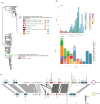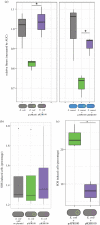A tale of two plasmids: contributions of plasmid associated phenotypes to epidemiological success among Shigella
- PMID: 35919999
- PMCID: PMC9346365
- DOI: 10.1098/rspb.2022.0581
A tale of two plasmids: contributions of plasmid associated phenotypes to epidemiological success among Shigella
Abstract
Dissemination of antimicrobial resistance (AMR) genes by horizontal gene transfer (HGT) mediated through plasmids is a major global concern. Genomic epidemiology studies have shown varying success of different AMR plasmids during outbreaks, but the underlying reasons for these differences are unclear. Here, we investigated two Shigella plasmids (pKSR100 and pAPR100) that circulated in the same transmission network but had starkly contrasting epidemiological outcomes to identify plasmid features that may have contributed to the differences. We used plasmid comparative genomics to reveal divergence between the two plasmids in genes encoding AMR, SOS response alleviation and conjugation. Experimental analyses revealed that these genomic differences corresponded with reduced conjugation efficiencies for the epidemiologically successful pKSR100, but more extensive AMR, reduced fitness costs, and a reduced SOS response in the presence of antimicrobials, compared with the less successful pAPR100. The discrepant phenotypes between the two plasmids are consistent with the hypothesis that plasmid-associated phenotypes contribute to determining the epidemiological outcome of AMR HGT and suggest that phenotypes relevant in responding to antimicrobial pressure and fitness impact may be more important than those around conjugation in this setting. Plasmid phenotypes could thus be valuable tools in conjunction with genomic epidemiology for predicting AMR dissemination.
Keywords: antimicrobial resistance; bacterial SOS response; conjugation; plasmid fitness cost.
Conflict of interest statement
Authors declare no competing interests
Figures



References
Publication types
MeSH terms
Substances
Associated data
Grants and funding
LinkOut - more resources
Full Text Sources
Medical
